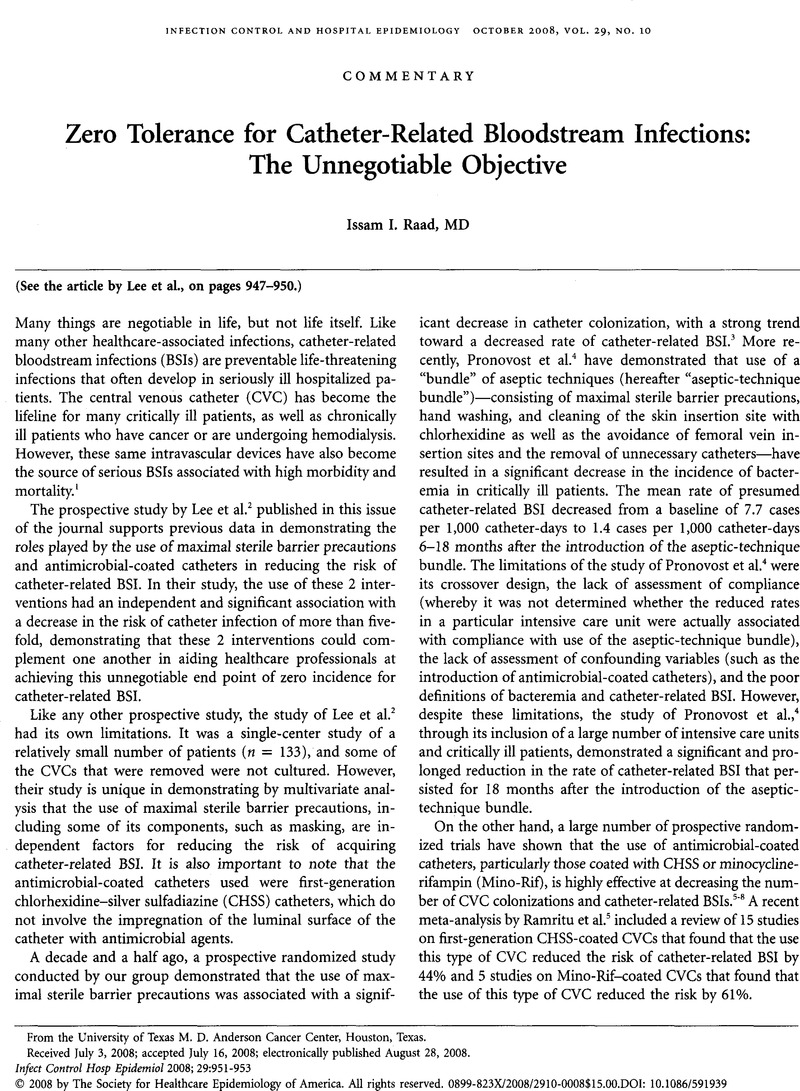Crossref Citations
This article has been cited by the following publications. This list is generated based on data provided by Crossref.
Jaouen, Richard
2010.
The Ugly Side of Practice Guidelines.
Plastic and Reconstructive Surgery,
Vol. 125,
Issue. 6,
p.
1848.
Wohoush, Iba Al
Chaftari, Anne-Marie
and
Raad, Issam
2011.
Principles and Practice of Cancer Infectious Diseases.
p.
113.
Ramos, Elizabeth R.
Reitzel, Ruth
Jiang, Ying
Hachem, Ray Y.
Chaftari, Ann Marie
Chemaly, Roy F.
Hackett, Brenda
Pravinkumar, S. Egbert
Nates, Joseph
Tarrand, Jeffrey J.
and
Raad, Issam I.
2011.
Clinical effectiveness and risk of emerging resistance associated with prolonged use of antibiotic-impregnated catheters: More than 0.5 million catheter days and 7 years of clinical experience*.
Critical Care Medicine,
Vol. 39,
Issue. 2,
p.
245.
Cherry-Bukowiec, Jill R.
Denchev, Krassimir
Dickinson, Sharon
Chenoweth, Carol E.
Zalewski, Christy
Meldrum, Craig
Sihler, Kristen C.
Brunsvold, Melissa E.
Papadimos, Thomas J.
Park, Pauline K.
and
Napolitano, Lena M.
2011.
Prevention of Catheter-Related Blood Stream Infection: Back to Basics?.
Surgical Infections,
Vol. 12,
Issue. 1,
p.
27.
Safdar, Nasia
and
Maki, Dennis G.
2011.
Principles and Practice of Cancer Infectious Diseases.
p.
123.
Raad, Issam
Mohamed, Jamal A.
Reitzel, Ruth A.
Jiang, Ying
Raad, Sammy
Al Shuaibi, Munirah
Chaftari, Anne-Marie
and
Hachem, Ray Y.
2012.
Improved Antibiotic-Impregnated Catheters with Extended-Spectrum Activity against Resistant Bacteria and Fungi.
Antimicrobial Agents and Chemotherapy,
Vol. 56,
Issue. 2,
p.
935.
Wu, Pin-Pin
Liu, Chun-Eng
Chang, Chih-Yen
Huang, Hsiao-Chun
Syu, Siou-Siou
Wang, Chu-Hsien
and
Huang, Yi-Chen
2012.
Decreasing catheter-related bloodstream infections in the intensive care unit: Interventions in a medical center in central Taiwan.
Journal of Microbiology, Immunology and Infection,
Vol. 45,
Issue. 5,
p.
370.
Worth, Leon J.
and
McLaws, Mary-Louise
2012.
Is it possible to achieve a target of zero central line associated bloodstream infections?.
Current Opinion in Infectious Diseases,
Vol. 25,
Issue. 6,
p.
650.
Rodríguez-Créixems, M.
Muñoz, P.
Martín-Rabadán, P.
Cercenado, E.
Guembe, M.
and
Bouza, E.
2013.
Evolution and aetiological shift of catheter-related bloodstream infection in a whole institution: the microbiology department may act as a watchtower.
Clinical Microbiology and Infection,
Vol. 19,
Issue. 9,
p.
845.
Yousif, Ammar
Chaftari, Anne-Marie
Michael, Majd
Jordan, Mary
Al Hamal, Zainab
Hussain, Alawami
Elizabeth, Natividad
Jiang, Ying
Hachem, Ray
and
Raad, Issam
2016.
The influence of using antibiotic-coated peripherally inserted central catheters on decreasing the risk of central line-associated bloodstream infections.
American Journal of Infection Control,
Vol. 44,
Issue. 9,
p.
1037.
Wagner, Victoria E.
and
Gupta, Nisha
2017.
Antimicrobial Coatings and Modifications on Medical Devices.
p.
127.
2017.
Prävention von Infektionen, die von Gefäßkathetern ausgehen.
Bundesgesundheitsblatt - Gesundheitsforschung - Gesundheitsschutz,
Vol. 60,
Issue. 2,
p.
171.
Safdar, Nasia
Abad, Cybele Lara R.
and
Maki, Dennis G.
2019.
Principles and Practice of Transplant Infectious Diseases.
p.
249.
Hill, Jocelyn
and
Garner, Rachel
2021.
Efficacy of 4% tetrasodium ethylenediaminetetraacetic acid (T-EDTA) catheter lock solution in home parenteral nutrition patients: A quality improvement evaluation.
The Journal of Vascular Access,
Vol. 22,
Issue. 4,
p.
533.





